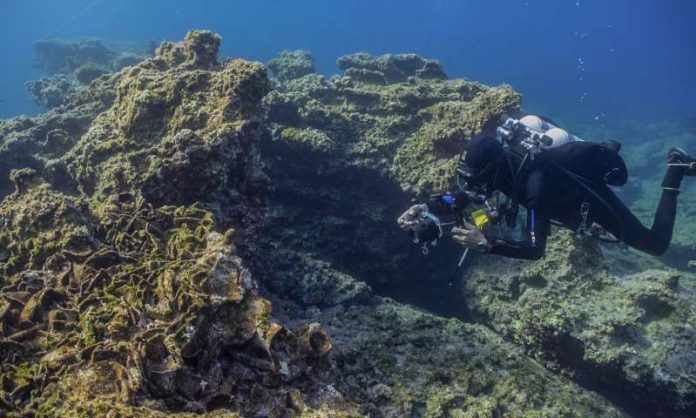Little by little, a sailboat from the late eighteenth or early nineteenth century begins to reveal its history in the waters around Chinchorro Bank, in the Yucatan Peninsula. The underwater archaeologists theorize how the crew of that vessel made a last effort to avoid the catastrophic event. This is inferred from the discovery of an “activated” anchor, that is, it was launched into the sea with the intention of attaching itself to the reef barrier to save the ship form running aground, and that today is fully outgrown with coral.
However, this action was in vain, and this wreck is a reminder of why the false atoll of Chinchorro Bank was known for centuries as “sleep depriver”. The remains of the sailboat represent shipwreck number 70, located by the Subdirectorate of Underwater Archeology (SAS) of the National Institute of Anthropology and History (INAH) in this natural reserve.
And although the details of that shipwreck recently began to “come to the surface” thanks to the national dissemination campaign “Contigo en la Distancia” by the Ministry of Culture, the findings are the result of the many years of research of this project.
Laura Carrillo Márquez, SAS researcher and head of the Banco Chinchorro Project, explains what it was like to locate and record this historic shipwreck during a first inspection carried out in two dives a few months ago.
It will be in a second phase of work —which will be carried out once the COVID-19 health contingency passes—, when the specialists return to the field to draw plans, record the wreck and delve into the characteristics of the context and perhaps take some samples to investigate its temporality. For now, the underwater archaeologist mentions, it is difficult to talk about the dimensions of the sailboat, its cargo or other details, since the area in which it is located, southeast of Banco Chinchorro, is complex. “It lies directly on the reef barrier where the ocean current is strong.”
The above, added to the fact that the wreck is barely two or three meters from the surface, means that there is practically nothing left of the wooden hull, since the organic material of that structure has disintegrated over the centuries. “Only the solid elements remain, incrusted into the reef”, describes Carrillo when listing some of the objects registered in the initial reconnaissance: pig iron ingots that were used as ballast, some tubes, a cannon approximately 2.5 meters long and an anchor ‘admiralty’, a term that designates the guides issued by the English for the manufacturers of these tools. Although some of the vestiges seem to indicate a British affiliation, the INAH researcher clarifies that this hypothesis must be yet corroborated or discarded, through analyzes that will be meticulously done, taking care of the natural environment of the site.
The history of the “Manuel Polanco” wreck
The fishermen are the ones who know Chinchorro best since they navigate it daily to earn their living, diving the Caribbean waters to find fish, lobsters or conch, that they sell in Mahahual or Xcalak, and often they happen to find submerged archaeological contexts.
Manuel Polanco is an example of this, because although he is now retired from diving, in the 60s and 70s, he found the remains of various shipwrecks, including two of the most iconic in Banco Chinchorro: “40 Cañones” and “The Angel”.
The octogenarian fisherman has also stood out for being an active collaborator in the protection of the underwater cultural heritage of the area and since those years he has spoken with archaeologists and specialists in favor of the conservation of this heritage.
In the 90s, Manuel led the engineer Peter Tattersfield to the fragments of a ship named “El Inglés”. Tattersfield, an enthusiast of underwater archeology and assiduous collaborator of the SAS, contacted in recent months the head of this instance of INAH, Roberto Junco Sánchez, and initiated the negotiations between Manuel Polanco and underwater archaeologists Laura Carrillo and Nicolás Ciarlo to visit the site.
A working group was formed, led by Carrillo, which included Peter Tattersfield, Carlos Gottfried, Daniel Maldonado, Pablo Sada, Manuel Pesqueira, Juan José Álvarez, David Patterson, Francisco Con, Álvaro Buenaventura and Juan Castro.
Although due to his advanced age, Manuel can no longer go out to sea, the group received the help of his son, Benito Polanco, a ship captain who, after listening to the directions, led the experts to the historic site.
It should be noted that one of the practices that SAS follows is to thank the help of its collaborators by naming some sites in honor of them. Thus, “El Inglés” has left this name behind to be officially registered as the “Manuel Polanco” wreck.
Among the sailboats, steamers and merchant ships of different nationalities and times, today there are 70 shipwrecks in Chinchorro Bank, that INAH has recorded, and protects and investigates, and with each new one found we can learn more about the last 500 years of navigation in American waters.








